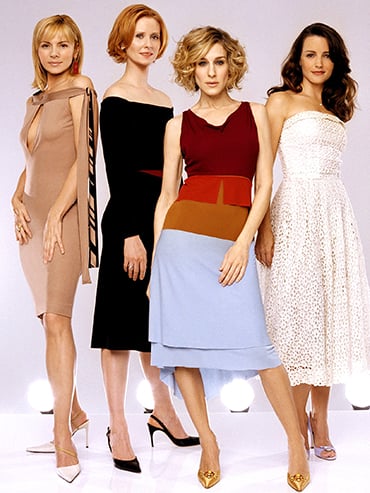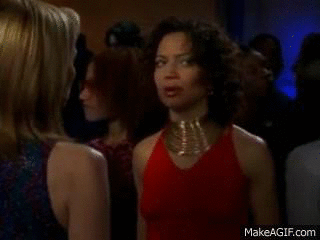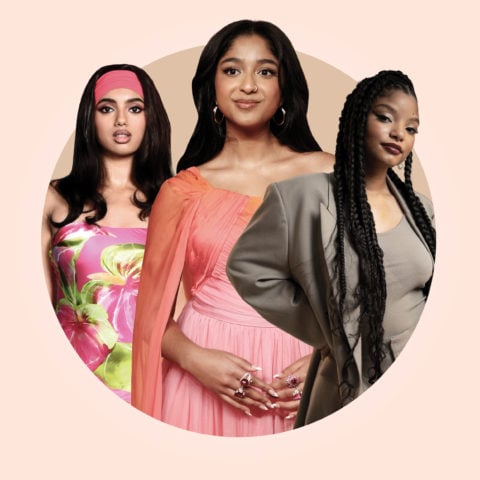Looking Back, Sex and the City Was Seriously Problematic for Black Women
"They were never great with anything having to do with race," says 'Grown-ish' writer Kara Brown


It’s been two decades since Sex and the City premiered and Carrie Bradshaw (Sarah Jessica Parker), Samantha Jones (Kim Cattrall), Miranda Hobbes (Cynthia Nixon) and Charlotte York (Kristin Davis) became the most talked about quartet since Golden Girls. I was barely old enough to tie my shoelaces at the time, let alone understand that when Samantha said, “I don’t see colour. I see conquests,” she was doing what the Sex and the City women did well and often: delivering micro and macro-aggressions with an acerbic wit that made their statements funny, while hiding their casual racism. It wasn’t until much later that I was able to fully understand the gravity of these women’s seemingly casual statements, and what message the series sent about race.
To be fair, this perspective on Sex and the City is all in hindsight and also came with age. It’s only now when I look back at the four most well-connected (fictional) women in New York that I see how often their politics worked against my own. I liked Sex and the City when I was younger. I might have even loved it. These women offered me a fun and dreamy escape from my dreary reality of puberty, growing pains and unrequited school yard love affairs. But after all this time, that love has now turned to loathing.
In her 2016 piece for Refinery29, writer Hunter Harris described having a similar revelation. “It was a show that was simultaneously progressive and regressive, where people of colour were either stereotypes or punchlines,” she wrote. And even Sarah Jessica Parker recently said, “there were no women of colour [in Sex and the City] . . . and there was no substantial conversation about the LGBTQ community.” Twitter user @Purify_toast17 expanded on these sentiments in a tweet thread.
I’m not saying the characters were racist. But those characters’ worlds were very white. It is what it is.
Plus, I don’t know of too many women of color who would’ve wanted to hang out with any of the Sex and the City characters.
— Purify (@Purify_toast17) May 13, 2018
That’s the problem with watching Sex and the City now—you see it as a series that framed itself as both radical and non-threatening.
According to Kara Brown—a journalist who is now a television writer on the hit FreeForm series, Grown-ish—it’s not surprising that Sex and the City contained moments that didn’t age as well as that unforgettable John Galliano newspaper dress. “Watching the show now, you will see and hear things that are a little homophobic, that are a little transphobic and that’s because the time we are living in now, people are a lot more politically aware than they might have been back then,” she says. But Sex and the City is iconic; it is lauded as not only television gold, but as an entertainment landmark that “deeply affected the social and cultural landscape of New York,” according to a 2010 Vanity Fair article. In fact, I’d argue that its sphere of influence extended far beyond NYC, and still does. After all, it’s still in syndication today. The oppressive misconceptions that existed when the show first aired 20 years ago persist even now—and that’s why it’s important to highlight its problematic moments that undermine the lived experiences of marginalized people.
I rewatched the series from beginning to end when I was in my late teens and that was when I fully realized my unease at its whiteness, how it accessorized queer characters and also represented women. The leading ladies of the show were created by author Candace Bushnell, but the characters were brought to life by show creator Darren Star and director Michael Patrick King. As a result of this male lens, there were certain instances where the women spoke and teenage me thought, wait, that is not how women talk. That is how men think women talk.
Take Season 1’s, “Models and Mortals,” which dedicated 30 minutes to the woes of everyday women who felt unable to compete with the omnipresent models in New York City, is a perfect example. According to Miranda, the existence of models, with their beauty and perfect bodies, made it impossible for women who weren’t a size zero to find love or feel desirable.

The episode clumsily looked at women’s body image in the way men understand it: as a product of insecurity and jealousy towards other women, rather than a reflection of the unattainable body standards set by a male gaze. And, the conversation was between four wealthy, able-bodied white women who used white models as the marker of beauty, so it failed to capture the racial intersections of desirability and what body image looks like for Black women who are hypersexualized and fetishized, while simultaneously being erased. What is dating like for Black women in New York who are not supermodels? Whose hair is not pin straight or perfectly wavy and whose bank accounts reflect the fact that they earn 63 cents for every dollar a white man makes? (White women earn 79 cents.)
In the city that was home to the artist who gave us “Hard Core” (Lil Kim), the politician who would become the first woman to run for the Democratic Party’s Presidential nomination (Shirley Chisholm) and just blocks from the site of the Stonewall riots, Sex and the City remained dedicated to only highlighting the experiences of cis straight white women.
I know it’s futile to expect this very white show to tell Black female stories. That would be like expecting Joan Collins to write a titillating novel on Black women and relationships. That being said, I’m still disappointed at the apparent lack of interest in the stories of non-white women. Intentional or not, there is a certain arrogance in assuming that one group of women experience problems that reflect the entirety of their gender without paying attention to race, sexuality and socio-economic status. As a Black woman, I am frustrated by the omission and as a writer I mourn the missed opportunity to capture vivid and layered experiences of non-white womanhood.
Season 3’s, “No Ifs, Ands or Butts,” is probably the episode that made clear the racial flaws in the series and proved the only way its writers knew to venture through the unchartered territory of interracial dating was by reverting to stereotypes. Naturally it was experimental Samantha, the self-proclaimed “try-sexual,” who found herself dating Chivon Williams (Asio Highsmith), a Black music executive and the brother of Carrie’s former colleague turned restaurateur, Adeena Williams (Sundra Oakely).
(Not so fun fact: A Black man would not be prominent again until the sixth and final season.)
Adeena had a problem with Samantha dating her brother because she was white and by vocalizing her discomfort, Sex and the City made her out to be a raging segregationist. Samantha, Sex and the City’s most (conveniently) liberal character had the final say, bashing Adeena where it would apparently hurt the most. “Your okra wasn’t even all that!” she yelled in the restaurant to the comical shock and horror of everyone present.

Thinking back on this episode, Brown says this was just an example of a larger issue with the series. “They were never great with anything having to do with race. Episodes like that [okra incident] and others where people of colour were just not treated well were one of the main things wrong with Sex and the City,” she says.
For me, this episode was 30 minutes of cringing, head shakes and kissing teeth (look it up, white people). I exhaled after it was over and I inhale sharply every time I see this rerun on TV because it reminds me of how the few Black characters featured in the series were reduced to nothing more than stereotypes, devoid of legitimate storylines and lacking any semblance of reality. In this episode, there was a hysterical angry Black woman, a hyper-sexualized yet somewhat doltish Black man, a triumphantly liberal white woman and the worst event summation in television history, offered in true white woman boldness by Carrie: “The problem was not Samantha’s white pussy. It was the fact that Chivon was a Black pussy who wouldn’t stand up to his sister.”
Overall, the four characters of Sex and the City left a lot to be desired. Samantha and Carrie offered the feminism peddled in mainstream media: superficial, myopic and white. My girls and I always said Miranda was the least likely to call the police on an unsuspecting, innocent Black person. In fact, she would probably try to learn as much as she could about affirmative action and regularly drop quotes from James Baldwin and Martin Luther King in casual conversation with Black people. Charlotte on the other hand would definitely call the police, the Air Marshals and probably the Governor on a Black person waiting for the bus outside her gallery. (A character flaw that the #WokeCharlotte meme is now trying to highlight).
Carrie starts off the series by calling their era, “The age of un-innocence,” and yet these women went through life with a social and racial naiveté that has aged about as well Gloria Steinem’s support of Bill Clinton in the wake of Monica Lewinsky (and her continued support after). Some Sex and the City moments are still enjoyable, but I can honestly say I’m thankful for the fast-forward button—and that there are old episodes of Girlfriends on YouTube.
Related:
The Problem with Rewatching Friends (All the Sexism, for Starters)
“There Is No Catfight:” SJP *Finally* Speaks Out About Her “Feud” with Kim Cattrall
Toronto Snagged the Final Stop on Manolo Blahnik’s Touring Exhibit








